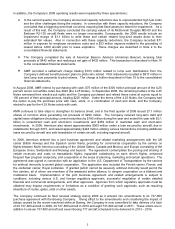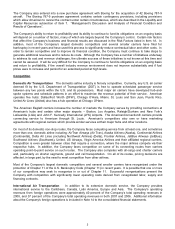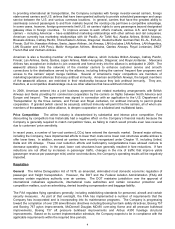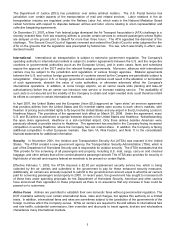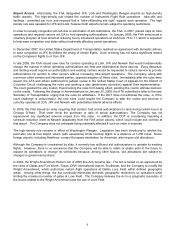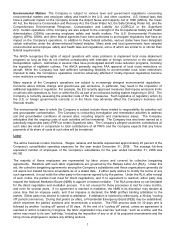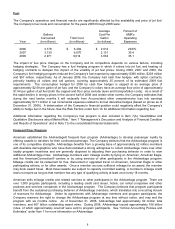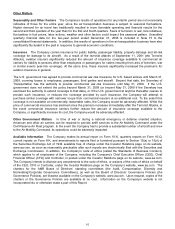American Airlines 2008 Annual Report Download - page 6
Download and view the complete annual report
Please find page 6 of the 2008 American Airlines annual report below. You can navigate through the pages in the report by either clicking on the pages listed below, or by using the keyword search tool below to find specific information within the annual report.
3
The Company also entered into a new purchase agreement with Boeing for the acquisition of 42 Boeing 787-9
aircraft. The Boeing 787-9 purchase agreement contains certain contingency provisions, including provisions
which allow American to cancel the contract under certain circumstances, which are described in the Liquidity and
Capital Resources subsection of Item 7. “Management's Discussion and Analysis of Financial Condition and
Results of Operations”.
The Company’s ability to return to profitability and its ability to continue to fund its obligations on an ongoing basis
will depend on a number of factors, many of which are largely beyond the Company’s control. Certain risk factors
that affect the Company’s business and financial results are discussed in the Risk Factors listed in Item 1A. In
addition, most of the Company’s largest domestic competitors and several smaller carriers have filed for
bankruptcy in recent years and have used this process to significantly reduce contractual labor and other costs. In
order to remain competitive and to improve its financial condition, the Company must continue to take steps to
generate additional revenues and to reduce its costs. Although the Company has a number of initiatives underway
to address its cost and revenue challenges, the ultimate success of these initiatives is not known at this time and
cannot be assured. It will be very difficult for the Company to continue to fund its obligations on an ongoing basis
and return to profitability, if the overall industry revenue environment does not improve substantially and if fuel
prices were to increase and persist for an extended period at high levels.
Competition
Domestic Air Transportation The domestic airline industry is fiercely competitive. Currently, any U.S. air carrier
deemed fit by the U.S. Department of Transportation (DOT) is free to operate scheduled passenger service
between any two points within the U.S. and its possessions. Most major air carriers have developed hub-and-
spoke systems and schedule patterns in an effort to maximize the revenue potential of their service. American
operates five hubs: Dallas/Fort Worth (DFW), Chicago O'Hare, Miami, St. Louis and San Juan, Puerto Rico.
United Air Lines (United) also has a hub operation at Chicago O'Hare.
The American Eagle® carriers increase the number of markets the Company serves by providing connections at
American’s hubs and certain other major airports – Boston, Los Angeles, Raleigh/Durham and New York’s
LaGuardia (LGA) and John F. Kennedy International (JFK) Airports. The AmericanConnection® carriers provide
connecting service to American through St. Louis. American's competitors also own or have marketing
agreements with regional carriers which provide similar services at their major hubs and other locations.
On most of its domestic non-stop routes, the Company faces competing service from at least one, and sometimes
more than one, domestic airline including: AirTran Airways (Air Tran), Alaska Airlines (Alaska), Continental Airlines
(Continental), Delta Air Lines (including Northwest Airlines) (Delta), Frontier Airlines, JetBlue Airways (JetBlue),
Southwest Airlines (Southwest), United, US Airways, Virgin America Airlines and their affiliated regional carriers.
Competition is even greater between cities that require a connection, where the major airlines compete via their
respective hubs. In addition, the Company faces competition on some of its connecting routes from carriers
operating point-to-point service on such routes. The Company also competes with all-cargo and charter carriers
and, particularly on shorter segments, ground and rail transportation. On all of its routes, pricing decisions are
affected, in large part, by the need to meet competition from other airlines.
Most of the Company’s largest domestic competitors and several smaller carriers have reorganized under the
protection of Chapter 11 of the U.S. Bankruptcy Code (Chapter 11) in recent years. It is possible that one or more
of our competitors may seek to reorganize in or out of Chapter 11. Successful reorganizations present the
Company with competitors with significantly lower operating costs derived from renegotiated labor, supply and
financing contracts.
International Air Transportation In addition to its extensive domestic service, the Company provides
international service to the Caribbean, Canada, Latin America, Europe and Asia. The Company's operating
revenues from foreign operations were approximately 40 percent of the Company’s total operating revenues in
2008, and 37 percent of the Company’s total operating revenues in both 2007 and 2006. Additional information
about the Company's foreign operations is included in Note 14 to the consolidated financial statements.





